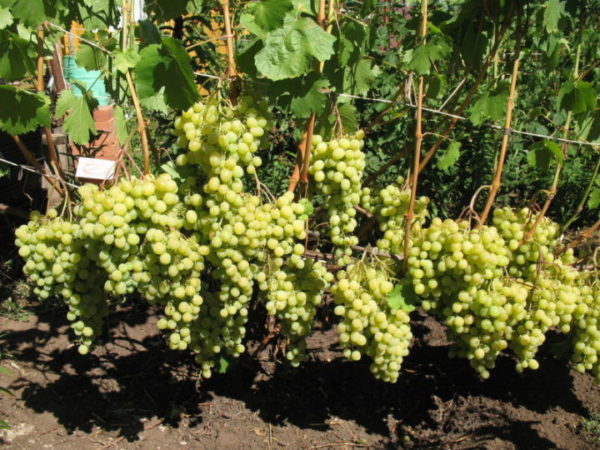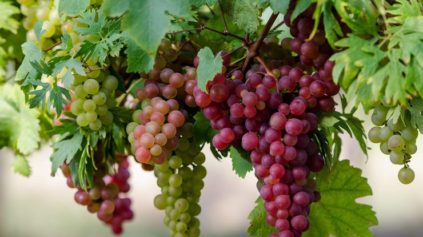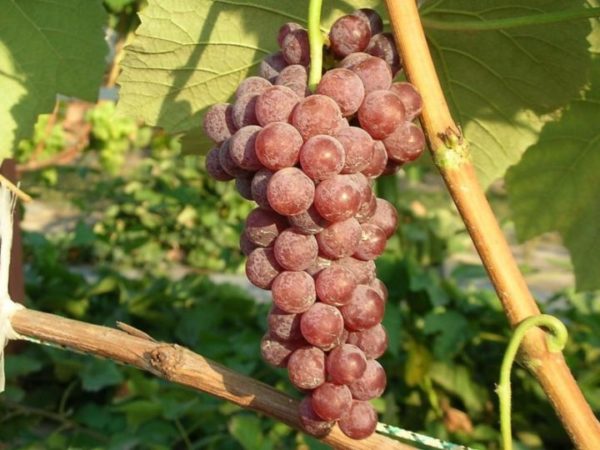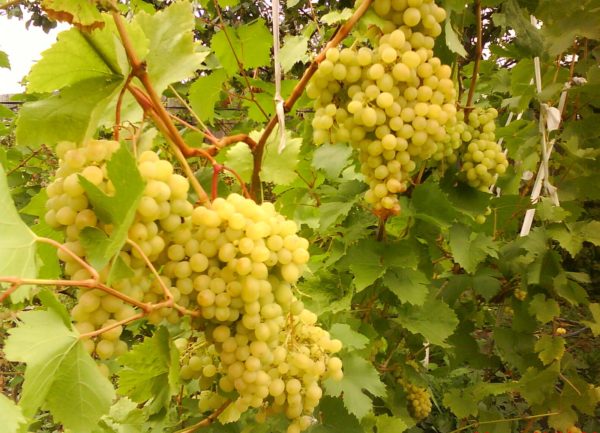Grapes are one of the most thermophilic and moody crops. In the south of Russia, any variety is grown without shelter; in other areas, such experiments most often end in partial or complete freezing of the vine in the winter. Gardeners in the middle lane have to deal with a lot of problems and make considerable efforts to get a good harvest. Check out the list of the best non-covering grape varieties for the Moscow Region, learn how to care for the crop in difficult climatic conditions.
Content
Non-covering grapes for the Moscow region
To grow grapes without shelter you need to choose frost-resistant varieties and preferably unpretentious. The climatic conditions of the Moscow Region can be compared with the northern regions, especially in recent years. Autumn here is quite short and cool, winter is frosty but snowy enough, the first spring month is usually cold, return frosts are often observed even at the end of May.
The basis for all winter-hardy grape varieties was the American version of Librusek. In addition to immunity to low temperatures, in the process of crossing, new forms acquire good resistance to various diseases and pests. Thanks to the work of breeders, residents of regions with a difficult climate have the opportunity to choose grapes for every taste.
| Grade | Days from vegetation to harvest | Resistance to frost (maximum mark) | Description and specifications |
| Aleshenkin | 118 | 26 | Brushes from 650 grams to 2.6 kilograms. Berries of 6-8 grams, oval, yellowish-green, sweet. With proper agricultural technology, an adult bush gives about 25 kilograms of crop per year. Immunity to fungal diseases is weak, to avoid troubles, bushes should be treated with copper-containing preparations every 2 weeks. |
| Alpha | 140–150 | 35 | The clusters are not large, cylindrical, dense. The grapes are round, blue with a pinkish-lilac hue. Taste with strawberry notes, but acid prevails. Productivity is up to 10 kilograms from one bush, in industrial conditions - up to 30 kilograms per year. Immunity to the main diseases of the culture and aphids is high, and to chlorosis is low. |
| Buffalo | 120–135 | 28 | Wine grapes with conical, dense, medium-sized brushes. The berries are round-oval, large, black-blue, sweet-sour. The taste resembles a forest pear, sugar content of about 22%. Productivity is up to 30 kilograms. Bushes are moderately resistant to typical diseases. |
| Victoria | 110–120 | 26 | Sweet, nutmeg variety, brushes of 650–950 grams, loose. The grapes are slightly elongated, 4-10 grams, dark pink. Victoria is usually grown for commercial purposes, due to the excellent taste, appearance of the brushes and good transportability. Sweet berries attract wasps. |
| Valiant | 120–130 | 45 | Brushes up to 100 grams of arbitrary shape with shoulders, very dense. The berries are blue-black, round, small, and the seeds are large. The taste is strawberry, sugar content from 18 to 20%. Productivity with proper care is high annually. Immunity to diseases is increased. |
| Pearl Saba | 115–120 | 28 | Brushes up to 150 grams are cylindrical, loose. The grapes are medium-sized, rounded, yellow-green. The taste is sweet-sour with a muscat shade, there are few seeds. Productivity up to 30 kilograms per bush. Immunity to gray rot is high, and to other diseases is average. Berries are attractive to birds and insects. |
| Isabel | 150–180 | 28 | Brushes 180–250 grams (rarely up to 2.5 kilograms), not very dense, inverted conical or cylindrical. The berries are spherical, sometimes uneven, dark purple, sour-sweet. There is a scent of strawberries. Productivity is up to 60 kilograms per year. Undemanding variety with high immunity to diseases typical of the culture. |
| Kishmish Radiant | 125–130 | 15 | Bunches of 750 grams, some brushes can weigh 2 kilograms, elongated, arbitrary shape, loose. The grapes are widely oval, up to 10 grams, pink-purple, seedless. The taste is balanced, with notes of muscat, sugar content of 18-22%. Brushes lend themselves well to transportation, berries are still. Productivity is up to 15 kilograms from one bush. The variety requires seasonal preventive treatments and normalization of the crop. With a lack of nutrition and moisture, the berries lose their taste. |
| Crystal | 110–130 | 30 | Technical grade. Brushes up to 190 grams are cylindrical, loose. Berries up to 4 grams, yellowish-green or whitish. The taste is balanced, pleasant, sugar content up to 18%. Immunity to fungi is above average; the variety is not affected by gray rot. The yield is not bad even in adverse years, when the bush thickens, the berries crumble. If cooling occurs during the ripening period, the taste of the berries will deteriorate. |
| Kristina | 115–125 | 23 | Arms of arbitrary shape or cone-shaped with shoulders, loose from 400 to 850 grams. The berries are widely oval up to 17 grams, greenish-golden with a pink blush. The taste of varietal. Due to the increased productivity, normalization is required. Immunity to fungi is high. |
| Kuderka or Kudrik | 115–120 | 30 | Brushes up to 380 grams of arbitrary shape, loose. An adult bush gives up to 90 kilograms of crop. The grapes are blue, spherical. Increased sugar content allows you not to use sugar in the manufacture of wine. Unpretentious variety, resistance to most diseases is excellent, except for phylloxera. |
| Lydia or Isabella | 150–160 | 26 | Brushes of 100-150 grams, arbitrary shape. The berries are broadly oval, brownish red with a purple hue. On the palate there is a strawberry hue, sugar content of 19–20%. An adult bush gives about 45 kilograms of the crop. Immunity to fungi is high, the variety is not afraid of waterlogging of the soil. |
| Transformation | 100–120 | 25 | Bunches from 450 grams to 2 kilograms, broad-conical, loose. The fruits are elongated, up to 17 grams, pale pink. The taste is harmonious. An adult bush gives up to 19 kilograms of crop. Medium immunity to fungi. With high humidity, the taste of berries deteriorates, the variety is attractive to wasps. |
| Sovering Tiara | 110–120 | 30 | Brushes up to 350 grams, conical, loose, sometimes broad-shouldered. Berries from 3 to 5 grams, spherical, green in color with a whitish hue. The taste is sweet and sour, there is the aroma of labrusca. Resistance to disease at a high level, productive variety. |
| Tason | 95–100 | 22 | Bunches of 400 grams and larger, cylindrical. Grapes of 8–9 grams, rounded oval, light red with a golden hue, sweet (sugar content 21%). The scent is nutmeg. Immunity to fungi is high, and to other diseases is low. Productivity is very high. |
| Phenomenon | 120 | 24 | The clusters are conical from 400 to 950 grams. Berries up to 12 grams, yellow with a whitish tinge, broadly oval, sweet and sour (sugar content up to 22%). Immunity to common diseases is elevated. Productivity is 25 kilograms per year. |
| Anniversary of Novocherkassk | 110–120 | 25 | Brushes up to 4 kilograms are cylindrical. Fruits of 12-18 grams, elongated oval, yellowish pink, two-tone or plain, sweet. Immunity to diseases of the culture is excellent, berries are attractive to wasps. Productivity is consistently high. |
| Jupiter | 110–115 | 27 | Bunches from 350 to 550 grams, arbitrary shape, loose. Berries up to 9 grams, elongated-oval reddish-purple, sweet (sugar content up to 30%) with musky notes. Immunity to fungi is excellent. If agricultural technology is observed, up to 250 centners of grapes can be collected from a hectare of land. |
When choosing a variety, focus on the maximum minus temperatures in your area, and not on average. Take into account not only the last year, but about 5-7 years. Be sure to pay attention to the ripening dates, take those varieties that have time to ripen before the onset of frost, lay fruit buds and go into a state of rest. We described the most suitable early grape varieties for the region.

Tips for growing grapes in the suburbs
One of the most important points - grapes grown from cuttings cannot be planted in open ground immediately after rooting. In the second year of life, young sprouts are transplanted into bulk containers and grown in a greenhouse or on the street, not forgetting about watering, feeding and disease prevention. Before the onset of frost, seedlings are transferred to the basement. The bushes are planted in a permanent place (by transshipment method), when the first clusters appear, it is necessary to carry out the procedure in the spring after return frosts.
Seat selection and landing
The vineyard should be placed on the south or south-west side of the site, preferably on a slope. The place should be sunny, protected from strong winds and cold drafts. Culture develops well only on chernozems or sandstones. The soil, in the composition of which there is sand more loose, better passes heat in the spring and freezes faster in winter. Grapes can not be planted in wetlands, under such conditions, the bush will often hurt or does not take root at all, there is a very high risk of root decay.
To make the bush fully matured and matured before the onset of cold weather, planting grapes in the suburbs carried out in April or May, and in the fall until the end of October. When planting in autumn, it is better to navigate by the long-term weather forecast in a certain area, to select a specific date so that at least 50 days remain before frost. In total there are 3 options for planting grapes in the Moscow region:
- landing in a pit - for planting grapes on sandstone, dig a pit 80x80x110 cm, if on a plot of black soil, the size of the hole is slightly different - 80x80x80 cm;
- landing in the trench - the length of the trench can be no more than a meter, and the depth is 80 cm. The trench is located from south to west;
- landing in a high bed - the method is suitable for those who do not have space on a slope or on a hill, and also if the selected site has a high level of groundwater. The embankment should be made about a meter, to hold the soil it can be fenced with boards.
 You may be interested in:
You may be interested in:The distance between the seedlings depends on the variety of grapes and the method of forming the bush. Most often, 1 or 2 meters are left between the holes, while the aisles are also made wide (about 1, 5 m). The support for the further garter of the bush must be taken care of when planting, so that later, when arranging the structures, grapes should not be broken off. Some varieties grow so fast that they require garter next year.

Proper care
Frost resistant grape varieties exhibit their properties gradually, therefore in the first and second year of cultivation the vine is covered, in the third year partial protection will be required. To check whether the bush has developed immunity to frost, one sleeve is left uncovered, the result is visible in the spring by the number of overwintered buds.Despite the fact that protection is necessary in the early years, there is a danger that due to the changing weather (either frost or thaw), the vine under the shelter of the vine will begin to churn or rot. How to care for grapes in the suburbs:
- in October, a mixture from a bucket of rotted manure, 40 grams of ammonium nitrate, 50 grams of potassium salt and 80 grams of superphosphate is introduced into the trunk circle (for digging). Before flowering and immediately after it, the bush is watered with a solution of superphosphate and ammonium nitrate (20 grams each) in a bucket of water;
- weeds are harvested throughout the growing season, the earth is always kept loose;
- in the first year after planting, the bush is watered every 30 days, at least 3 buckets of water should go under the bush. If heavy rain falls on the appointed date, additional hydration is not required. In subsequent years, they are limited only by spring watering, as well as in prolonged drought. The climate in the Moscow Region is humid; overflow of the vineyard will result in shedding of flowers;
- annual shoots are not cut in the autumn, but nipped at a height of 1, 7 m. When forming frost-resistant grapes, a standard or gazebo is used.
Do not forget about the preventive treatment of the vineyard from diseases and pests, often they are needed even to varieties with good immunity. The weather in the Moscow Region is variable, constant dampness is an excellent condition for the development of infections, due to which various epidemics often occur in the region. Preventing the disease is much easier than curing the affected bush. It is advisable to carry out the treatments before the buds open, before flowering and after the harvest.

Reviews
Leonid
Cottage in Chekhov, planted 2 Crystal bushes for wine, in the bush Sowering Tiara and Alpha for food. There is no slope on the site, and a well-lit place was occupied, making a high mound of earth for each bush. At first, I started the whips horizontally, the branches gradually braided arched structures, now I am only thinning the crown and removing dry shoots. The first 3 years he covered the grapes with a spanbond (on arcs), mulched the ground in near-stem circles with a 10 cm layer of overripe straw. When spring thaws came, he opened the grapes partially, completely removed the protection immediately after return frosts.
Zahar
I live in Sergiev Posad, for 12 years of viticulture I have tried many varieties, stopped at Kudrika, Victoria, Aleshenka and Alpha. I spend the main pruning in the fall, in the spring I clean the non-overwintered branches. Some varieties require normalization, this procedure cannot be ignored, otherwise the brushes will not ripen before the onset of frost. In our region, grapes cannot be left without top dressing; frequent rains wash nutrients from the soil into deeper layers, to which the roots of young bushes do not reach.
A wide variety of grape varieties allows growing it in almost all regions of Russia, except for overly cold regions, but even there gardeners manage to plant the crop in the greenhouse. We have compiled a list of the best varieties for the middle band, if you wish, you can search for other options in local nurseries or in catalogs, taking into account the characteristics of frost resistance. If the area allows you to choose not one, but several options at once, follow our tips and you will annually collect good harvests of your favorite berry.

 Non-covering winter-hardy grape varieties for Moscow region
Non-covering winter-hardy grape varieties for Moscow region How to keep the vine in winter
How to keep the vine in winter When can I transfer grapes to another place in the fall
When can I transfer grapes to another place in the fall How to cover and prepare grapes for the winter in the suburbs
How to cover and prepare grapes for the winter in the suburbs